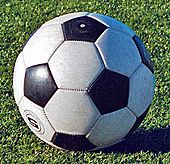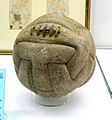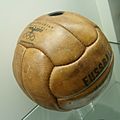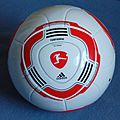Ball (association football) facts for kids

A football, soccer ball, football ball, or association football ball is the ball used in the sport of association football. The name of the ball varies according to whether the sport is called "football", "soccer", or "association football". The ball's spherical shape, as well as its size, weight, and material composition, are specified by Law 2 of the Laws of the Game maintained by the International Football Association Board. Additional, more stringent standards are specified by FIFA and subordinate governing bodies for the balls used in the competitions they sanction.
Early footballs began as animal bladders or stomachs that would easily fall apart if kicked too much. Improvements became possible in the 19th century with the introduction of rubber and discoveries of vulcanization by Charles Goodyear. The modern 32-panel ball design was developed in 1962 by Eigil Nielsen, and technological research continues today to develop footballs with improved performance. The 32-panel ball design was soon overcome by 24-panel balls as well as 42-panel balls, both of which improved performance compared to before, in 2007.
A black-and-white patterned spherical truncated icosahedron design, brought to prominence by the Adidas Telstar, has become an icon of the sport. Many different designs of balls exist, varying both in appearance and physical characteristics.
Contents
Specification
Construction
Today's footballs are much more complex than past footballs. Most modern footballs consist of twelve regular pentagonal and twenty regular hexagonal panels positioned in a truncated icosahedron spherical geometry. Some premium-grade 32-panel balls use non-regular polygons to give a closer approximation to sphericality. The inside of the football is made up of a latex or butyl rubber bladder which enables the football to be pressurised. The ball's outside is made of leather, synthetic leather, polyurethane or PVC panels. The surface can be textured, weaved or embossed for greater control and touch. The panel pairs are either machine-stitched, hand-stitched or thermo-bonded (glued and bonded by heat) along the edge. To prevent water absorption balls may be specially coated, or the stitches bonded with glue. The size of a football is roughly 22 cm (8.66 inches) in diameter for a regulation size 5 ball. Rules state that a size 5 ball must be 68 to 70 cm (27 to 28 in) in circumference. Averaging that to 69 cm (27 in) and then dividing by π gives about 22 cm (8.7 in) for a diameter.
Size and weight
Regulation size and weight for a soccer ball is a circumference of 68–70 cm (27–28 in) and a weight of between 410–450 g (14–16 oz). The ball should be inflated to a pressure of 0.6 and 1.1 bars (8.7 and 16.0 psi) at sea level. This is known as "Size 5". Smaller balls, sizes 1, 3 and 4 are also produced. These are designed for younger players or as training tools.
Types of ball
There are a number of different types of football balls depending on the match and turf including training footballs, match footballs, professional match footballs, beach footballs, street footballs, indoor footballs, turf balls, futsal footballs and mini/skills footballs.
- Professional/Premium Match Soccer Balls are developed with top professional clubs to maximize players natural abilities and skills. They are FIFA-approved for use at the highest professional and international levels and designed for performance, exact specifications, great accuracy, speed and control. Air retention, water-resistance, and performance are far superior when compared to a training ball. Intended for all natural and artificial turf surfaces and all climates. These are the most expensive soccer balls.
- Matchday Soccer Balls are high performance range of balls for all playing surfaces. The outer casing is either leather or an approved synthetic and it will typically be water-resistant as well. They are guaranteed to conform to official size, weight, and texture regulations, designed to suit all levels of play and all age groups. These balls cost more than turf or training balls, which is offset by their superior level of quality.
- Recreational/Practice/Training Soccer Balls are tough and highly durable balls for extended use. Made of robust materials for use on all playing surfaces and used by players at any level. Practice balls are the least expensive balls when compared with match type soccer balls.
- Turf Balls are specifically designed to work on artificial surfaces that mimic grass. They are durable and reasonably affordable, but tend to skip more when used on a natural pitch.
- Promotional Balls are usually made to promote a name brand, organization or event.
- Indoor Soccer Balls come in the same sizes as the outdoor soccer balls, but are designed to have less bounce and rebound in them, making it possible to control the ball on a smaller court or indoor arena. The cover of an indoor ball is also the strongest of any category, so it can withstand the hard rebound impact on the court flooring and wall surfaces.
- Futsal Soccer Balls differ from typical soccer balls in that the bladder is filled with foam. That makes the ball heavier and with less bounce for use on the hard futsal playing surface. Besides that, a futsal soccer ball is smaller in size than a football used in the soccer field.
Suppliers
Many companies throughout the world produce footballs. The earliest balls were made by local suppliers where the game was played. It is estimated that 55% of all footballs are made in Sialkot, Pakistan, with other major producers being China and India.
As a response to the problems with the balls in the 1962 FIFA World Cup, Adidas created the Adidas Santiago – this led to Adidas winning the contract to supply the match balls for all official FIFA and UEFA matches, which they have held since the 1970s, and also for the Olympic Games. They also supply the ball for the UEFA Champions League which is called the Adidas Finale.
FIFA World Cup
In early FIFA World Cups, match balls were mostly provided by the hosts from local suppliers. Records indicate a variety of models being used within individual tournaments and even, on some occasions, individual games. Over time, FIFA took more control over the choice of ball used. Since 1970 Adidas have supplied official match balls for every tournament.
League balls
The following lists the most up-to-date balls used in various club football competitions (as of 2020-21 season):
| Balls used in football leagues | |
|---|---|
| Ball | League |
| Adidas Conext 21 | FIFA Club World Cup (FIFA) |
| Adidas Finale 2020 (Group stage matches only) Adidas Finale Istanbul (Knockout stage and the final only) |
|
| Molten Europa League | |
| Nike Flight | |
| Nike Flight CONMEBOL 2021 | |
| Nike Flight CONMEBOL 2021 | |
| Nike Flight CONMEBOL 2021 | |
| Nike Flight | CONCACAF Champions League (CONCACAF) |
| Nike Flight | CONCACAF League (CONCACAF) |
| Adidas Tsubasa | AFC Champions League (AFC) |
| Adidas Tsubasa | AFC Cup (AFC) |
| Umbro Pro Precision | CAF Champions League (CAF) |
| Umbro Pro Precision | CAF Confederation Cup (CAF) |
| Pasifika Taniwa | OFC Champions League (OFC) |
| Puma Accelerate Puma Adrenalina (Derbies and decisive matches only) |
|
| Puma Accelerate Puma Adrenalina (Derbies and decisive matches only) |
|
| Adidas Uniforia | |
| Adidas Uniforia | |
| Nike Flight 2020 (First half of the season) Nike Flight 2021 (Second half of the season) |
|
| Mitre Delta Max | |
| Mitre Delta Max | |
| Mitre Delta Max | |
| Nike Flight | |
| Kappa Kombat Ball 2021 | |
| Puma | |
| Puma | |
| Derbystar Brillant APS | |
| Derbystar Brillant APS | |
| Adidas Uniforia | |
| Adidas Uniforia | |
| Adidas Uniforia | |
| Uhlsport Elysia 2020 (First half of the season) Uhlsport Elysia 2021 (Second half of the season) |
|
| Uhlsport Triomphéo | |
| Nike Flight | |
| Voit Bliss | |
| Derbystar Brillant APS | |
| Nike Flight | |
| Golty | |
| Nike Flight | |
| Adidas Argentum | |
| Nike Flight | |
| Select Brilliant Super | |
| Adidas Uniforia | |
| Nike Flight | |
| Nike Flight | |
| Adidas Tsubasa | |
| Adidas Tsubasa | |
| Puma | |
| Adidas Telstar 18 | |
| Adidas Nativo | |
| Derbystar Brillant APS | |
| Nike Flight | |
| Nike Flight | |
| Nike Merlin | |
| Molten VG-5000A | |
| Adidas Brazuca | |
| Select Brilliant Super | |
| Select Brilliant Super | |
| Select Brilliant Super | |
| Select Brilliant Super | |
| Select Brilliant Super | |
| Voit | |
| Nivia Ashtang | |
| Nike Ordem 3 NWSL 2016 | |
| Nike Ordem 3 | |
| Dong Luc Group Galaxy UHV 2.07 | |
| Grand Sport Group Primero Mundo 5 | |
| Mitre Delta Max | |
| Mitre Delta | |
| Mitre Delta Hyperseam | |
| Mitre Delta Hyperseam | |
| Mitre Delta Max | |
| Mitre Delta Max | |
| Mitre Delta Max | |
| Adidas Conext 21 Spain | |
| Nike Flight | |
| Adidas Uniforia | |
| Nike Flight | |
| Mitre Delta Max | |
| Mitre Delta SPFL | |
| Mitre Delta V12 | |
| Mitre Delta WPL | |
| Nike Merlin | |
| Nike Merlin | |
Unicode
The association football symbol (Error using : Input "26BD" is not a hexadecimal value.) was introduced by computing standard Unicode. The symbol was representable in HTML as ⚽⚽
Images for kids
-
Leather ball used in the football tournament at the 1936 Summer Olympics
-
Adidas Torfabrik football used in the Bundesliga in 2011
See also
 In Spanish: Balón de fútbol para niños
In Spanish: Balón de fútbol para niños





